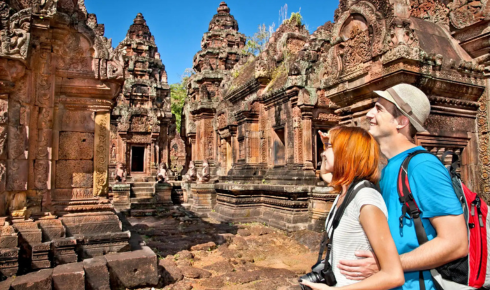Cambodia, a captivating country nestled in Southeast Asia, offers a rich tapestry of ancient history, stunning landscapes, vibrant culture, and welcoming people. From the iconic temples of Angkor Wat in the north to the untouched beaches of the south, every region of Cambodia has something special to offer year-round. But when planning your dream journey, timing matters. The weather in Cambodia varies significantly depending on the region and season, and with numerous Cambodia festivals dotting the calendar, picking the best time to visit can enhance your experience tremendously.
What is Cambodia’s Climate Like Throughout the Year?
Cambodia experiences a tropical monsoon climate with two distinct seasons: the dry season and the wet season. The dry season spans from November to April, while the wet season lasts from May to October. Temperatures generally range from 25°C to 35°C (77°F to 95°F), with humidity higher during the rainy months.
While most travelers lean toward the dry months, particularly between December and February when the weather is cooler and more comfortable for exploring, the rainy season can still be a rewarding time to visit. The countryside is lush and green, the temples are quieter, and travel deals on Cambodia tour packages are often more affordable.
Northern Cambodia (Siem Reap, Angkor Wat, Preah Vihear)
Dry Season (November to March):
This is the peak tourist period, especially in Siem Reap. The days are sunny and slightly cooler, making it perfect for temple-hopping and outdoor adventures. Angkor Wat at sunrise during this season is a magical experience. If you’re keen on photography or visiting less crowded sites like Beng Mealea or Preah Vihear, this is your best window.
Wet Season (May to October):
While afternoon showers are common, mornings often remain dry. The Angkor temples look particularly striking against the backdrop of green rice paddies and moody skies. Fewer tourists mean a more intimate experience, especially for travelers who don’t mind getting a bit wet.
Festivals in the North:
The Angkor Festival, typically held in December, showcases traditional dance, music, and theater right near the temples. It adds a cultural dimension to your visit that’s hard to beat.
Southern Cambodia (Phnom Penh, Kep, Kampot, Sihanoukville)
Dry Season (December to April):
Perfect for beach lovers and foodies. The southern coast boasts warm, dry weather that’s ideal for exploring Kep’s crab markets, Kampot’s pepper plantations, or the beaches around Sihanoukville and the Koh Rong islands. Phnom Penh also feels more vibrant during this period, with riverside cafés and rooftop bars offering beautiful evening views.
Wet Season (May to October):
Rains often come in short, heavy bursts and tend to be predictable. This season brings life to the lush countryside and waterfalls near Kampot. While beach days might be limited, it’s a great time for cultural exploration and culinary experiences.
Festivals in the South:
Phnom Penh becomes especially lively during Khmer New Year in April, with street celebrations, traditional games, and water fights. In September or October, Pchum Ben—a religious holiday where Cambodians honor their ancestors—offers a deeper look into the country’s spiritual traditions.
Eastern Cambodia (Mondulkiri, Ratanakiri, Kratie)
Dry Season (November to February):
The best time for trekking, wildlife spotting, and visiting waterfalls. Mondulkiri and Ratanakiri, known for their hill tribes and dense forests, offer a cooler climate due to their elevation. Kratie, along the Mekong River, is great for spotting endangered Irrawaddy dolphins.
Wet Season (June to October):
Roads can become muddy and harder to navigate, but the region’s natural beauty intensifies. Lush forests, flowing waterfalls, and quieter villages give visitors a glimpse into untouched Cambodia.
Festivals in the East:
While fewer large-scale festivals happen in this part of Cambodia, the traditional Bunong and Khmer communities often celebrate local rituals and harvest-related events during the rainy season, making it ideal for cultural immersion.
Western Cambodia (Battambang, Pursat, Tonle Sap)
Dry Season (December to March):
Ideal for exploring Battambang’s colonial architecture, countryside, and bamboo train ride. The floating villages of Tonle Sap Lake are also easier to access when the water levels start receding.
Wet Season (May to October):
Tonle Sap expands dramatically during the rains, turning it into the largest freshwater lake in Southeast Asia. This is the best time to see the floating villages in their full splendor, where homes, schools, and markets move with the tides.
Festivals in the West:
The Water Festival (Bon Om Touk), usually held in November, is one of the biggest festivals, especially vibrant in areas connected to the Tonle Sap and Mekong rivers. It celebrates the reversal of the Tonle Sap River’s current and features boat races, music, and dancing.
Is the Rainy Season Worth Considering?
Absolutely. While travelers often avoid Cambodia during the wet season, this period has its own unique charm. The landscape bursts into vibrant greens, rural life thrives, and the major attractions become refreshingly peaceful. With the added benefit of lower prices on Cambodia tour packages and accommodations, it can be a smart time for those who prefer offbeat experiences.
Just plan ahead—carry a light raincoat, quick-dry clothing, and waterproof footwear. In most regions, rains fall in the late afternoon or evening, so you’ll still have plenty of dry hours to explore.
Tips for Choosing the Best Time for Your Trip
- Weather in Cambodia isn’t extreme, but if you want to avoid humidity and heat, opt for December through February.
- Book accommodations and tours in advance during peak travel months.
- Check local calendars for Cambodia festivals, as some temple sites or cities may become crowded or have limited access during major holidays.
- If you’re into nature or photography, the rainy season offers striking skies, misty mountains, and fewer crowds.
Frequently Asked Questions (FAQs)
Q: When is the most popular time to visit Cambodia?
The peak tourist season runs from December to February when the weather is cooler and dry. This period is ideal for sightseeing and outdoor activities.
Q: Is it safe to travel during the rainy season in Cambodia?
Yes, it’s generally safe. Roads in remote areas might become difficult, but main tourist hubs remain accessible. Be prepared for short, heavy rain and plan your activities accordingly.
Q: Which month has the least rainfall in Cambodia?
January is typically the driest month, offering ideal conditions for travel across all regions.
Q: What should I pack if visiting during the wet season?
Lightweight rain gear, waterproof shoes, and breathable clothes are must-haves. A dry bag for electronics and valuables is also helpful.
Q: Are there specific festivals worth planning a trip around?
Yes! Major festivals like Khmer New Year (April), the Water Festival (November), and regional celebrations during harvest season offer vibrant and immersive experiences.
Whether you’re a culture seeker, a nature lover, or simply chasing sunshine, Cambodia has a perfect season for your journey. From wandering through ancient ruins to enjoying street food in bustling markets or watching monks at dawn in sleepy villages, your timing can elevate every moment. So, consider the weather, festivals, and your personal travel style—then pick the perfect season to experience the best of this beautiful country.

